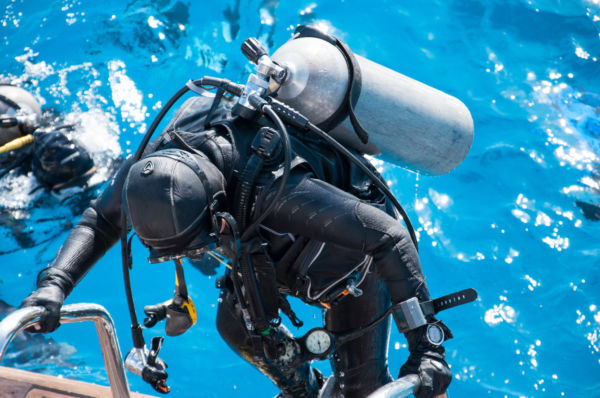This year has been challenging on so many levels, with the coronavirus crisis disrupting everyone’s lives. For numerous divers, not being able to get underwater has been tough. As a result, you would be forgiven for wanting to get back in the water as soon as possible. We feel the same and can’t wait for our next diving trip. To help you get ready, here are our tips for safely returning to diving after a long break.
First things first — if you have been diagnosed with and recovered from Covid-19, you must see a specialist before diving again. While scientists are learning more about the virus on a daily basis, we know that, in many people, coronavirus attacks the lungs and other vital organs. This means that only an appropriately qualified physician can sign you off to dive.
For everyone else, however, it is more about coming up with a plan for returning to diving after a long break. What’s the best way to safely get back underwater?
Physical fitness

Physical fitness is one of the key factors for safe diving. Some of you may have spent the better part of 2020 devising new fitness regimes and improving your diet, but many of us have enjoyed quality time with our couch and Netflix instead. If you’re part of the latter group, building up strength and stamina in good time before a dive trip is wise.
Diving itself may seem effortless, especially when you’re gliding along a tropical reef in a mild current, with a boat waiting to pick you up when you surface. Consider the other parts of a diving day, though, as this is often when fitness comes in handy.
Even if you are valet diving, with someone else transporting and preparing your gear, being in good physical condition is helpful. Balancing your weight, including equipment, just before a giant stride off the boat is one thing. Climbing a ladder after a dive is another. And on the dive, being able to efficiently kick through a current for a short time will help you return to the exit point.
When shore diving, entries and exits are often the most demanding parts of the dive. Having the strength to walk your equipment in and out of the water makes the entire dive more efficient and therefore safer.
To achieve this, you don’t have to start a full-on fitness regime. You’re unlikely to stick to that if you have been a couch potato for months. Instead, consider adding short walks to your daily routine or incorporating brief exercise routines and strength training. You can start very simply in your own home with a handful of squats or push-ups.
Build up slowly

Just like you built your diving experience slowly, coming back after a long break will take time. It might be tempting to look at the last dive in your logbook and try to repeat it straight away. However — especially if that was a pinnacle dive — pushing the boundaries of your existing diving experience, it’s not a great first dive back.
Getting back into diving is not about rushing. In fact, the opposite is true. Just as you might test a bunch of new equipment for the first time in the pool, consider doing the same. Granted, it’s not an exciting dive site, but it’s the best place to check if everything still fits and works as you expect it to. It’s also a good place for a weight check. Remember, you will need to adjust weights if you are changing suits or heading into saltwater after the pool.
With that squared away, consider your underwater comfort zone and start with a dive that is well within it. A couple of diving days in familiar conditions, if possible, will allow you to build confidence and regain muscle memory. Take it slowly and enjoy the process.
Technical diving
Starting slowly is even more important when you’re building up to deeper or longer technical dives after a break. You may be qualified to dive hypoxic trimix to 325 feet (100 meters) but going from a year on land to five or six cylinders at depth is simply a recipe for disaster. Maybe you were accustomed to hours-long, shallow cave dives. After months out of the water, however, your stamina is likely diminished. If your rebreather has gathered dust for months, it’s probably time to service the unit before even attempting to head to the pool. With the unit ship-shape, consider a refresher for yourself.
Note that refreshing your skills doesn’t necessarily mean booking a course as such. A similarly or higher qualified dive buddy may be able to help. Filming yourself practicing skills also goes a long way toward finding weak points and improving them.
Just as you completed your training in several stages, your return to diving after this year or possibly longer will take some time. The good news is, however, that all this underwater time is enjoyable. Put simply, diving cautiously is part of your return to diving to the top level of your qualification.
Refresher dives for newbies
Technical divers may be on one end of the spectrum. On the other hand, there are those who may have just completed their qualification before taking this long break. If you are one of those newly qualified divers and had to spend several months out of the water, we recommend a refresher course with an instructor or divemaster. Open water certification courses pack a lot of information into a short space of time. Not everyone can consolidate and solidify this information with a couple dozen dives straight away – and these dives are crucial to truly commit diving skills to memory.
It may feel like you’re repeating part of your initial certification course, but practice truly leads to mastery. After all, it makes more sense to practice not only until you can get something right, but rather until you can’t get it wrong anymore.
Whichever way you choose to get back to diving after a long break — coronavirus-related or not —to take things step by step. Rushing into big dives is never a good idea.

